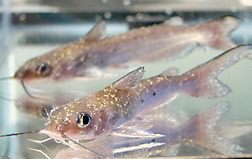This page has been archived and is being provided for reference purposes only. The page is no longer being updated, and therefore, links on the page may be invalid.
| Read the magazine story to find out more |
|
|
Helping Fish Get Rid of the "Ich"
By Sharon DurhamOctober 28, 2010
Copper sulfate has emerged as an effective treatment for Ichthyophthirius multifiliis, also known as "Ich," a protozoan parasite that appears as white spots on infected fish, according to a U.S. Department of Agriculture (USDA) scientist.
Aquatic toxicologist David Straus with USDA's Agricultural Research Service (ARS) investigated copper sulfate as a method to control both Ich in catfish and a fungus—Saprolegnia—on catfish eggs. Straus works at the ARS Harry K. Dupree Stuttgart National Aquaculture Research Center in Stuttgart, Ark. ARS is the chief intramural scientific research agency of USDA, and this research supports the USDA priority of promoting international food security.
Ich is considered the most prevalent parasite worldwide in ornamental fish, baitfish and food fish, according to Straus. Ich is less common in U.S. aquaculture because of management techniques, but when it occurs, it can kill all the fish in a pond or raceway. It is calculated that Ich was directly responsible for $1.2 million in losses to the catfish industry in 2003.
The freshwater fungus Saprolegnia is another major pathogen in fish culture, killing eggs and invading wounds and lesions on juvenile and adult fish.
Straus found copper sulfate is an effective treatment for Ich on fish and fungus on eggs. According to Straus, copper sulfate is the only practical treatment to control Ich in catfish ponds that average about 10 acres in area. It is easy to use, effective and inexpensive, and is safe for the user to handle.
Current approved treatments for fungus on eggs, such as formalin and hydrogen peroxide, are much more expensive. Also, both compounds are hazardous, and there are human safety concerns as well as required storage precautions.
Copper sulfate is not currently approved by the U.S. Food and Drug Administration for therapeutic use in aquaculture, but regulatory action has been deferred pending the outcome of Straus' ongoing research. The chemical is approved by the U.S. Environmental Protection Agency as an algicide and molluscicide. Fish farmers use copper sulfate to control cyanobacteria that cause off-flavor in fish, and to control snails that transmit parasitic flatworms to fish.
Read more about this and other aquaculture-related research in the October 2010 issue of Agricultural Research magazine.

